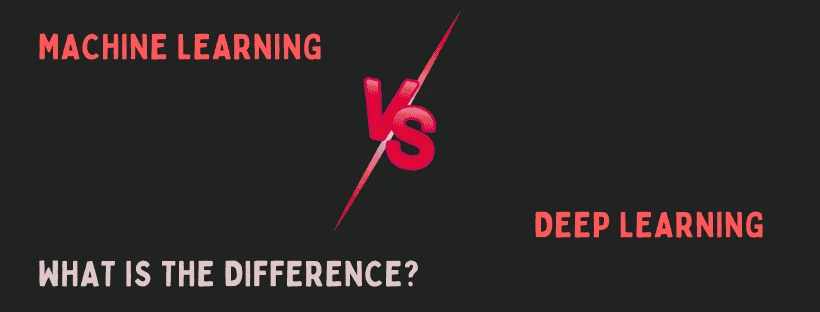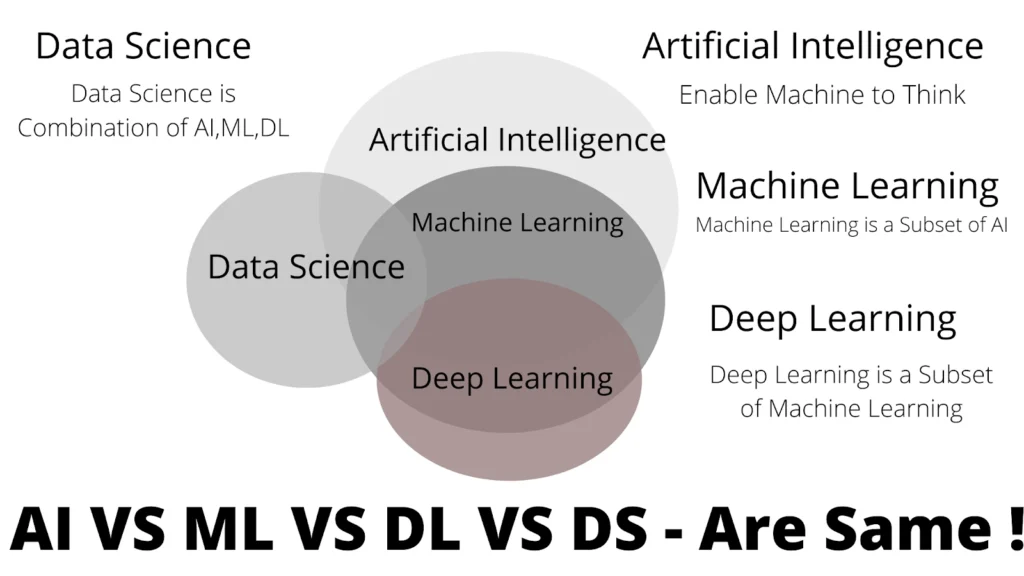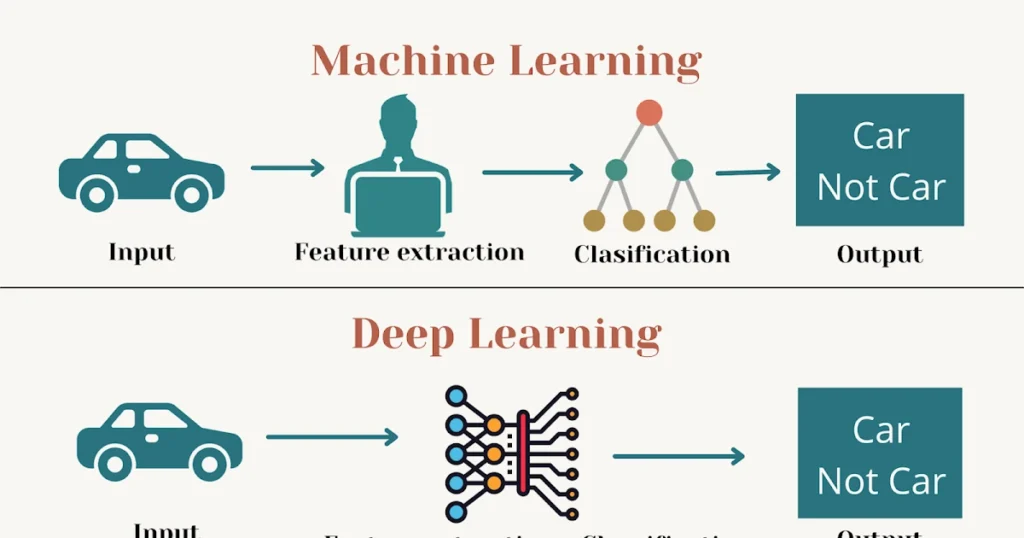
Machine Ever wonder how your photo gallery recognizes the faces in the photos or how your phone makes word suggestions as you type? Two contemporary technologies, machine learning and deep learning, are responsible for these incredible feats.
Despite the fact that they frequently collaborate, they are not the same thing. You will discover the meaning of each, their differences, and their applications in this blog, free of technical jargon.
First, let’s review the fundamentals.
What is machine learning?
Through a technique called machine learning vs deep learning computers can learn from examples rather than being given precise instructions. Similar to machine learning, deep learning is similar to how the human brain functions, but with a much more powerful brain.
The term “machine learning vs deep learning” refers to the fact that it makes use of numerous layers of microscopic learning units called neurons that cooperate to form a neural network.
Imagine this:
Consider a youngster who is learning to identify a cat. The child initially doesn’t know what a cat looks like. But the child begins to notice after seeing a lot of cats:
The ears are pointed.
A whisker
Fur
The Tail
“Machine learning vs Deep Learning” performs the same task, but it picks up these characteristics on its own without your guidance.

Section 1: “[Machine learning vs deep learning]”
The Principal Disparities
Let’s take a side-by-side comparison of” machine learning and deep learning:”
The Principal Disparities
Let’s take a side-by-side comparison of” machine learning and deep learning:”
“Machine Learning vs deep learning” Features-depth Education
Data Functions well with small to medium amounts of data; requires a large amount of data; requires powerful hardware (such as GPUs); and can be operated on a standard computer.
Learning Style: Acquires features at its own pace or with human assistance quicker to train, slower, and more time-consuming
Examples Email spam filter, basic forecasting Anonymous vehicles, image recognition
Section 2:”[machine learning vs deep learning]”
Analogies to Real Life
Let’s say you are instructing a child and a smart robot.
“Machine Learning vs deep learning”, the child, requires some assistance. You say, “To find a cat, look for whiskers and pointy ears.” As time passes, the child gets better at listening.
Actually, deep learning is a slightly more sophisticated form of machine learning vs deep learning
Recall the child from before? Imagine for a moment that you made no explanation. You simply handed them thousands of images of dogs and cats with no guidance. They eventually deduce it on their own by merely identifying patterns in the pictures. That is similar machine vs deep learning.
Neural networks, which are based on the functioning of the human brain, are used in “machine learning deep learning”. Because these networks have layers—many layers—deep learning gets its name.
It can learn more complicated things the more layers it has. It goes one step further with “machine learning vs deep learning” It’s similar to allowing someone to learn by doing without your intervention.
They go to enough coffee shops, make notes in their minds, and eventually, on their own, they determine what makes a good one. Without much help ,”machine learning vs deep learning” systems attempt to learn everything from the data, including what to look for, how to look for it, and what choices to make. These systems,
which make use of “neural networks,” are modelling after the functioning of the human brain. In essence, they use code and data to attempt to replicate how we link ideas and thoughts
What Is Deep Learning? (Think: Letting the Student Explore on Their Own)
Imagine a student who is more advanced now. You give them a bunch of fruit and tell them to “figure it out” rather than labelling examples of apples and oranges. They begin classifying objects based on colour shape, and size, and gradually they begin to identify patterns on their own. “Machine learning vs Deep learning” is based on this fundamental principle.
This type of learning is more successful because the system teaches itself not only the solution but also where to look for it. Instead of telling the user to “look at the colour and texture,” machine learning vs deep learning analysis the raw data—such as the sounds in a recording or the pixels in an image—on its own to find those details.
To do this, it employs layers, which is why “deep” learning. It is a more potent type of learning in which the system teaches itself not only the answer but also what to look for in order to find it.
By examining the raw data, such as pixels in an image or sounds in a recording, deep learning determines those details without the need to be told, “Look at the colour and texture.” The reason it is called “machine learning vs deep learning ” is because it accomplishes this through layers. Consider it a sequence of filters, each of which identifies a more profound and abstract aspect of the pattern.
Deep Learning Examples in the Real World
The more sophisticated things we see around us are powered by deep learning, particularly when it comes to complex, messy data like sounds, images, or video. You’ve undoubtedly encountered the following examples: On phones, face unlocking allows your face to be recognized even in dimly lit areas or with glasses.
Voice assistants can understand your words despite background noise or different accents. Automatic translation: Converting a language into another while maintaining a natural sound. Lane-keeping or self-parking vehicles: Real-time awareness of the environment, traffic, and signage.
These tools have learned from vast amounts of data and have been refined through trial and error, so they don’t simply follow a script. However, keep in mind that they were created, supervised, tested, and refined by people.

So, What’s the Difference Between the Two?
“Machine learning vs Deep Learning” ,Examples in the Real World The more sophisticated things we see around us are powered by deep learning, particularly when it comes to complex, messy data like sounds, images, or video. You’ve undoubtedly encountered the following examples: On phones, face unlocking allows your face to be recognized even in dimly lit areas or with glasses.
Voice assistants can understand your words despite background noise or different accents. Automatic translation: Converting a language into another while maintaining a natural sound. Lane-keeping or self-parking vehicles: Real-time awareness of the environment, traffic, and signage.
These tools have “machine learned vs deep learning “from vast amounts of data and have been refined through trial and error, so they don’t simply follow a script. However, keep in mind that they were created, supervised, tested, and refined by people.
Why Humans Still Matter (A Lot)
Here’s the most important thing to remember: none of this happens without people. Yes, these systems learn—but they only learn what we show them. They need us to: Decide what problems to solve. Gather and clean the data. Design and test the learning process. Make ethical choices about how results are used.
A system might be able to spot cats in photos, but only because thousands of people labelled those photos in the first place.
A voice system might understand spoken commands, but only because it was trained on real voices—recorded, sorted, and checked by people. Even when a system gets things wrong, it’s humans who go back, review the errors, and adjust the process. It’s not just about building something smart—it’s about building something useful, fair, and understandable.
Why Should You Care?
You don’t have to be a developer or a tech geek to care about this stuff. These systems are shaping the world we live in—how we shop, how we drive, how we work, and how we communicate.
Understanding the difference between” machine learning and deep learning” helps you: Make better decisions about the tools you use or invest in. Ask better questions when working with tech teams.
Spot hype when something sounds to good to be true. Stay informed about where the world is heading. And most importantly—it reminds you that behind every smart system is a group of real people making real choices. This isn’t about magic. It’s about effort, curiosity, trial and error, and a lot of human work
Final Thoughts
At the end of the day, “machine learning and deep learning” are just tools. One is simpler and more guided. The other is more powerful but requires more effort and care. Neither is “better” in a general sense—it all depends on what you need.
But here’s what’s always true: it all starts with people. The system “machine learning vs deep learning” from us, improve with us, and exist to help us do things better. The more we understand how they work—and the differences between them—the more wisely we can use them.
So the next time someone drops a tech term in a conversation, you don’t have to tune out. You’ll know exactly what they’re talking about—and maybe even explain it better than they ca-
‘Machine learning vs deep learning” s teaching a computer to identify patterns by showing them examples, while deep learning is doing it in a more sophisticated way by using layers of connected logic to understand complex ideas.
Think of “machine learning vs deep learning “as giving your system a recipe, and deep learning as letting it learn how to cook by watching thousands of chefs.
While the two approaches depend on data to enhance the process, deep learning requires significantly more information and the resources to handle it.
Classic machine learning necessitates a human to identify the relevant features while deep learning is able to do this by itself.